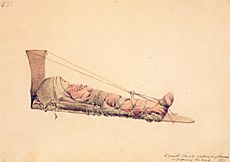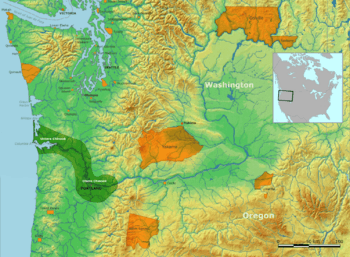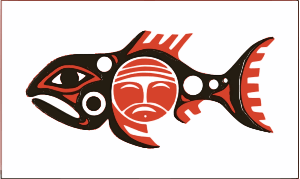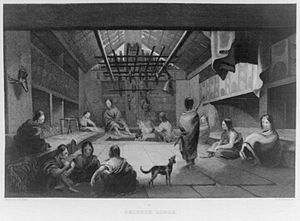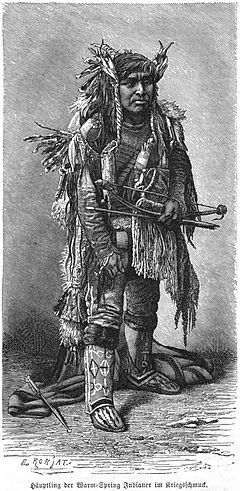Chinookan peoples facts for kids
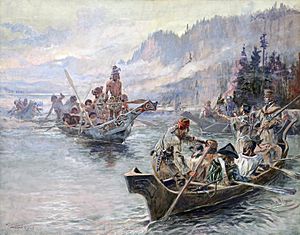
Chinook people meet the Corps of Discovery on the Lower Columbia, October 1805
(by Charles M. Russell, 1905) |
|
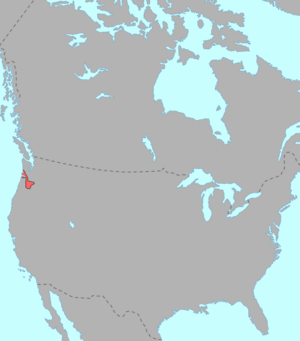
Location of Chinookan territory early in the 19th century
|
|
| Total population | |
|---|---|
| 2700 | |
| Regions with significant populations | |
| United States (Oregon – Washington) |
|
| Languages | |
| Chinook Jargon, English, formerly Chinookan languages | |
| Religion | |
| traditional tribal religion |
The Chinookan peoples are several groups of Native American people in the United States. They traditionally speak Chinookan languages. For thousands of years, these groups have lived along the Lower and Middle Columbia River (which they called "Wimahl" or "Great River"). Their lands stretched from the river's gorge in present-day The Dalles, Oregon all the way to the river's mouth. They also lived along the nearby coasts, from Tillamook Head in Oregon north to Willapa Bay in southwest Washington. In 1805, the famous Lewis and Clark Expedition met the Chinook Tribe near the lower Columbia River.
The word "Chinook" can also refer to the Chinook Jargon, which is a trade language that uses some Chinookan words. To avoid confusion, experts use "Chinookan" to talk about the older, original languages. There are different ideas about where the name "Chinook" came from. Some believe it's a word from the Chehalis language, Tsinúk, meaning "Fish Eaters" or referring to a village on Baker Bay. Others think it means "strong fighters."
Today, some Chinookan peoples are part of larger, federally recognized tribes. These include the Yakama Nation, the Confederated Tribes of the Warm Springs Reservation, and the Confederated Tribes of the Grand Ronde Community. The Chinook Indian Nation is another important group. It includes five western Chinookan tribes: the Cathlamet, Clatsop, Lower Chinook, Wahkiakum, and Willapa Chinooks.
The Chinook Indian Nation has been working to get federal recognition from the U.S. government. This recognition is important because it provides certain benefits and acknowledges their status as a sovereign nation. They were recognized in 2001, but this recognition was later taken away. They continue to seek this important status.
Contents
Chinook History and Culture
Daily Life and Social Structure
The Chinookan peoples were settled in their traditional areas. They were skilled hunters and fishermen, with salmon being a very important part of their diet. Women gathered many foods like nuts, seeds, and roots. Their society had different social levels, with some people having higher status than others. Important people included shamans (spiritual leaders), warriors, and successful traders. These high-status individuals made up a smaller part of the community.
Some Chinookan tribes practiced slavery, where people captured in warfare became slaves. Slaves were sometimes used to do tasks that high-status people considered beneath them.
A unique practice among the elite of some tribes was head binding. This involved gently shaping a baby's forehead and the top of their skull. This was done when the baby was about 3 months old and continued for about a year. This custom showed a person's social status; those with flattened heads had a higher rank than those with round heads. People with flattened skulls would not enslave others who also had flattened skulls, showing that a round head was linked to being a servant. Early explorers sometimes called the Chinook "Flathead Indians" because of this practice.
Living near the Pacific Ocean, the Chinook were excellent elk hunters and fishermen. Because they lived in settled communities, they had fewer conflicts over land than some other tribes. They had plenty of natural resources. The Chinook lived in large longhouses made from red cedar planks. These houses were often 20–60 feet wide and 50–150 feet long. More than fifty people, often from the same extended family, lived together in one longhouse.
Language and Storytelling Traditions
The Chinookan peoples have a rich tradition of storytelling and a unique language. Many stories and words have been recorded by researchers.
Franz Boas (1858-1942)
Franz Boas was a famous anthropologist who studied the Chinookan peoples. In 1888, he published "The Journal of American Folk-Lore," which included "Chinook Songs" in both Chinook and English.
He also collected "Native Legends of Oregon and Washington" in 1893. This book contained many Chinook legends and stories from his visits to Oregon and Washington in the early 1890s.
In 1894, Boas wrote "Chinook Texts." This important book shares myths, beliefs, customs, and historical tales directly from the Chinookan people.
George Gibbs (1815–1873)
George Gibbs was another important anthropologist. He put together an "Alphabetical Vocabulary of the Chinook Language." He got help from traders and others because there were not many Chinookan speakers left at the time. This book was mainly created to help with trading.
Chinook People Today
Chinookan peoples have lived along the lower Columbia River for a very long time. In the 20th century, these tribes and bands reorganized. They created an elected government and worked to bring back their traditional culture.
They began seeking official federal recognition in the late 20th century. This recognition would give them certain benefits for education and welfare, as promised in old treaties. In 1997, the government first rejected their request. Since then, the Chinook Indian Nation has continued to work hard to get formal recognition. They have done a lot of research to show their long history.
In 2001, the U.S. Department of Interior officially recognized the Chinook Indian Nation. This group is a confederation of the Cathlamet, Clatsop, Lower Chinook, Wahkiakum, and Willapa Indians. This recognition happened during the last months of President Bill Clinton's time in office.
However, after President George W. Bush was elected, his new team reviewed the decision. In 2002, they took away the recognition from the Chinook and two other tribes. This was a very unusual step. Efforts to get Congress to pass a law for their recognition have not yet been successful.
The Chinook Indian Nation has offices in Bay Center, Washington. They hold an Annual Winter Gathering at a traditional plankhouse in Ridgefield, Washington. They also have an Annual First Salmon Ceremony at Chinook Point (Fort Columbia) on the Columbia River. In 2019, the Chinook Indian Nation bought ten acres of the land where the 1851 Tansy Point treaty was signed.
Chinookan Groups
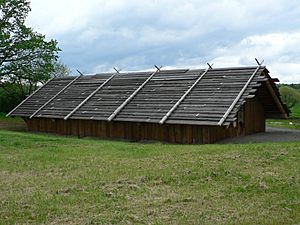
Here are some of the groups that speak Chinookan languages:
- Lower Chinook (lived at the mouth of the Columbia River in Washington)
- Kathlamet or Cathlamet (lived at the mouth of the Columbia River in Oregon and Washington)
- Clackamas or Cathlascans (lived along the Clackamas and Sandy Rivers in the Willamette Valley, Oregon. In 1806, Lewis and Clark estimated their population at 1,800. Today, some are part of the Confederated Tribes of the Grand Ronde Community of Oregon.)
- Clatsop (lived around the mouth of the Columbia River and the Clatsop Plains in northwestern Oregon. Chief Coboway welcomed Lewis and Clark. Today, many are part of the Chinook Indian Nation.)
- Clowwewalla (also called (Willamette) Falls Indians, lived in the Willamette Valley, Oregon. They were greatly affected by an epidemic in 1829 and are now mostly gone, though some may survive as part of the Clackamas.)
- Wasco-Wishram
- Wasco (lived on the south bank of the Columbia River in Oregon. They were divided into groups like the Dalles Wasco and Hood River Wasco. Today, about 200 tribal members of the Confederated Tribes of Warm Springs are Wasco.)
- Wishram (lived on the north bank of the Columbia River in Washington. Their village, Nixlúidix, was a major trading center. Today, most are part of the Confederated Tribes and Bands of the Yakama Nation.)
- Chilluckittequaw or Chiluktkwa (lived on the north side of the Columbia River in Washington. Lewis and Clark estimated their number at 2,400 in 1806. A few still lived near the Cascades in 1895.)
- Watlata or Cascades Indians (lived downstream from other Wasco groups, on both sides of the Columbia River at the Cascades. They are now enrolled as part of the Confederated Tribes of Warm Springs.)
- Multnomah or Cathlascans (lived in many villages on Sauvie Island (Wappatoo / Wapato Island) and along the Willamette (Multnomah) River. They were known as "Wapato people" because of the important Wapato plant they ate. Today, some are part of the Confederated Tribes of Siletz Indians and the Confederated Tribes of the Grand Ronde Community of Oregon.)
- Skilloot (lived on both sides of the Columbia River between the Washougal River and Cowlitz River. In 1806, their population was estimated at 2,500. They no longer exist as a separate group.)
- Wahkiakum (lived in villages along the Elochoman River in Washington. They are part of the Confederated Tribes of Siletz Indians and the Chinook Indian Nation.)
- Willapa Chinook (lived along the north bank of the Columbia River in southwest Washington, around southern Willapa Bay. Today, they are enrolled in the federally recognized Shoalwater Bay Tribe and the Chinook Indian Nation.)
In the 21st century, many Chinook people live near the towns of Bay Center, Chinook, and Ilwaco in southwest Washington, and in Astoria, Oregon.
Notable Chinook People
- Comcomly: A powerful chief in the early to mid-1800s.
- Charles Cultee: He was a main helper for anthropologist Franz Boas in his studies of the Chinook language and tribes, especially for the book Chinook Texts.
- Ranald MacDonald: The son of a Scottish fur trader and Chief Comcomly's daughter. In 1847–1848, he was the first Westerner to teach English in Japan.
- J. Christopher Stevens: An American diplomat who served as the U.S. Ambassador to Libya.
- Catherine Troeh: A historian, artist, and activist who worked to support Native American rights and culture. She was an elder of the Chinook tribe and a direct descendant of Chief Comcomly.
- Chief Tumulth: He signed the 1855 treaty that created the Grand Ronde Reservation.
- Tsin-is-tum: Also known as "Princess Jennie Michel," she was a Native American storyteller and was called "Last of the Clatsops."
See also
In Spanish: Chinook (tribus) para niños


